If you’re looking for a gourmet-style dish that doesn’t keep you long in the kitchen, you’ll love my shrimp linguine! This pasta recipe is so simple to make, yet the flavors are vivid and mouthwatering. It makes a fantastic dish to serve at fancier gatherings or a romantic date night, and it’s also easy enough to prepare for a weeknight dinner.
Simply serve linguine with shrimp as is for a lighter lunch or dinner. Or pair the zesty dish with homemade garlic bread or breadsticks and a simple side salad for a full-spread meal. It is also delicious served with a nice white wine like Sauvignon Blanc or Chardonnay. If you’re looking for more seafood recipes, try my shrimp scampi, shrimp alfredo, or seafood pasta.
What You Need To Make This Recipe

Linguine – it wouldn’t be a recipe for shrimp linguine without the noodles! Use white, wheat, or a gluten-free version for dietary preferences.
Butter – I recommend using unsalted butter so you can best control the seasoning of the recipe. You can use a standard butter or add extra richness to the dish by choosing a European-style butter.
Olive Oil – use extra virgin olive oil for the best, most authentic Italian flavor for the shrimp and linguine sauce.
Shrimp – choose fresh uncooked, peeled, and deveined large shrimp if you can find them. If not, frozen raw shrimp will work. If using frozen, thaw them first and pat dry to remove excess moisture.
Garlic – choose fresh garlic bulbs that are firm and plump. In a recipe like this, where the ingredients are minimal, fresh is best! If you’re in a pinch, you can use ¼ teaspoon of garlic powder to replace each clove of garlic.
Lemon – you will need two lemons for fresh lemon juice, lemon zest, and thin lemon slices. I recommend zesting the first lemon before juicing it and saving the second lemon just for slicing.
Seasonings – a simple combination of ground black pepper, salt, and red pepper flakes accentuates the other flavors in the shrimp pasta recipe.
Parsley – fresh parsley adds a slightly peppery flavor and vibrant pop of color that enhances the presentation. Swap it out for fresh basil or chives for added flavor, if desired.
Parmesan cheese – use freshly grated parmesan from the block to get the richest creamy flavor. Otherwise, opt for your favorite brand of grated parmesan.
How To Make Shrimp Linguine

1. Bring a large pot of salted water to a boil over medium-high heat. Add the linguine noodles and cook until al dente, according to package directions, for about 8-9 minutes. Drain well and set aside.
2. While the pasta boils, heat the butter and olive oil in a large skillet over medium heat, stirring occasionally until the butter melts. Add the fresh shrimp and garlic. Cook, stirring occasionally and turning the shrimp, until the shrimp are pink, opaque, and cooked through, for about 2-3 minutes.

3. Stir in the lemon juice.
4. Add the parsley, lemon zest, lemon slices, salt, pepper, and red pepper flakes until well combined. Reduce the skillet to medium-low heat.

5. Add the cooked pasta to the skillet and toss with tongs until well combined.
6. Serve immediately topped with freshly grated parmesan cheese and a drizzle of a little olive oil.

Purchasing the Best Shrimp
There are so many varieties of shrimp available at the grocery store, so it can be overwhelming to know which is the best. If you have access to fresh shrimp that was caught nearby, that’s likely to be the top tier! Not everyone has that luxury, so if you’re shopping your seafood counter at your local grocery store, ask the fishmonger what’s freshest and most flavorful from their current selection.
If you’re shopping for frozen shrimp, look for a red or pink shrimp that is described as “sweet” if possible. Wild caught is typically more flavorful than farmed. Argentinian Red Shrimp are super flavorful and fairly easy to find frozen. Frozen seafood is sometimes fresher than the seafood counter, so I fully support this option! Just be sure to fully thaw it before cooking.
How to Peel and Devein Shrimp
To peel shrimp: If the head is still attached, twist it and pull it off. Then, pinch the legs with your thumb and pointer finger and crack open the shell. Peel the shell off, much like peeling an orange. You can leave the tail on or pinch it where the tail meets the shrimp and pull it off.
To devein shrimp: Make a shallow cut along the back of each shrimp with a sharp pairing knife. Slightly pull the slit apart if it doesn’t naturally open for you, and you’ll see the “vein.” Lift it out using the tip of the knife, and discard it. Then, rinse the shrimp in cold water.
What is Shrimp Linguine vs Shrimp Scampi?
The most notable difference between the two is the inclusion or absence of pasta! Shrimp scampi is a light dish made by cooking fresh shrimp in a garlic butter sauce flavored with white wine and fresh lemon. While the flavors are similar to shrimp linguine, shrimp scampi doesn’t contain pasta and is typically eaten alongside crusty bread. Shrimp linguine follows a similar cooking method but has fresh pasta tossed into the garlic butter sauce.

Can I Use a Different Type of Pasta?
Yes, you can substitute linguine with other pasta types you enjoy. Shrimp and pasta recipes like this one go best with long noodles like spaghetti, fettuccine, or bucatini. If desired, you can also use a short-shaped pasta like penne, casarecce, or cavatappi.
Add White Wine to the Sauce
If you love this recipe but also love the flavors of a shrimp scampi, add a crisp white wine like Pinot Grigio to the sauce. Follow the recipe as outlined, and before adding the cooked pasta to the sauce, remove the cooked shrimp with a slotted spoon and add ½ cup of white wine to the pan with the butter. Simmer over medium heat for 2 minutes. Stir the shrimp back in, then continue with the recipe as directed.
Pro Tips For Making This Recipe
- Generously salt the pasta water. Salting the water adds significant flavor to the pasta and enhances the texture, making it perfectly firm yet tender. For the best results, I recommend using about 1-2 tablespoons of salt per gallon of water.
- Achieve the perfect sauce consistency. Reserve ¼-½ cup of pasta water before you drain the noodles and gradually stir it into the cooked sauce after you add the cooked pasta until you have achieved a saucy consistency that coats all of the pasta. This will also enhance the overall flavor of the dish!
- Leave shrimp tails on. This is optional, but you can leave the tails of the shrimp on (still removing the main shells) to add flavor and enhance the presentation of the dish. Or, if you prefer, remove the tails before cooking.
- Add extra veggies. Feel free to include additional vegetables like spinach, asparagus, or cherry tomatoes for added flavor and texture.

Frequently Asked Questions
This shrimp linguine recipe is best served right away, but you can also store leftovers if needed. Allow the dish to cool to room temperature before storing it in an airtight container in the refrigerator for up to 3-4 days.
Reheat on the stovetop with a slash of water or chicken broth to restore the moisture or in the microwave until heated through. I don’t recommend freezing this recipe, as it will lose its texture.
Use a citrus zester, microplane, or fine grater to lightly graze back and forth on the outermost yellow peel of a fresh lemon. Avoid the inner white pith of the peel, as it has a bitter taste. I recommend zesting one of the lemons you plan to use for juicing before you juice it.
When cooked, shrimp will become opaque and, depending on the variety, turn pink or bright coral in color. Shrimp cook very quickly (2 to 4 minutes, depending on how large they are) and become rubbery when overcooked, so keep a close eye on them.
If you’ve tried this Shrimp Linguine recipe, then don’t forget to rate it and let me know how you got on in the comments below. I love hearing from you!

Shrimp Linguine
Ingredients
- 12 ounces linguine noodles (342g)
- 3 tablespoons unsalted butter
- 2 tablespoons olive oil
- 1 pound large shrimp peeled and deveined (450g)
- 6 garlic cloves finely chopped
- ⅓ cup lemon juice (about 3 lemons) (80mL)
- 3 tablespoons chopped fresh parsley
- 1 tablespoon lemon zest
- 1 lemon thinly sliced into half rounds
- 1 teaspoon salt
- ½ teaspoon ground black pepper
- ½ teaspoon red pepper flakes
- ¼ cup grated Parmesan cheese (20g)
Instructions
- Bring a large pot of salted water to a boil over medium-high heat. Add the linguine noodles and cook until al dente according to package directions, 8 to 9 minutes. Drain well and set aside.
- While the pasta boils, heat the butter and olive oil in a large skillet over medium heat, stirring occasionally until the butter melts. Add the shrimp and garlic. Cook, stirring occasionally and turning the shrimp, until the shrimp are pink, opaque, and cooked through, 2 to 3 minutes.
- Stir in the lemon juice, parsley, lemon zest, lemon slices, salt, pepper, and red pepper flakes until well combined. Reduce to medium-low heat.
- Add the cooked pasta and toss to combine. Serve immediately topped with Parmesan cheese.
Notes
- Generously salt the pasta water. Salting the water adds significant flavor to the pasta and enhances the texture, making it perfectly firm yet tender. For the best results, I recommend using about 1-2 tablespoons of salt per gallon of water.
- Achieve the perfect sauce consistency. Reserve ¼-½ cup of pasta water before you drain the noodles and gradually stir it into the cooked sauce after you add the cooked pasta until you have achieved a saucy consistency that coats all of the pasta. This will also enhance the overall flavor of the dish!
- Leave shrimp tails on. This is optional, but you can leave the tails of the shrimp on (still removing the main shells) to add flavor and enhance the presentation of the dish. Or, if you prefer, remove the tails before cooking.
- Add extra veggies. Feel free to include additional vegetables like spinach, asparagus, or cherry tomatoes for added flavor and texture.









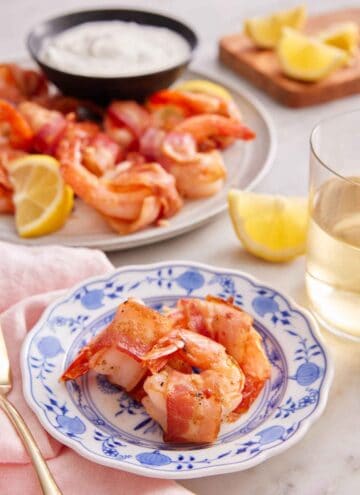
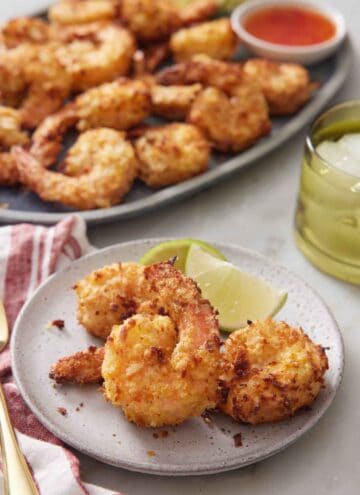
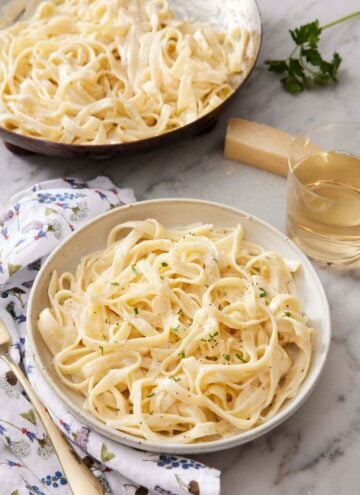
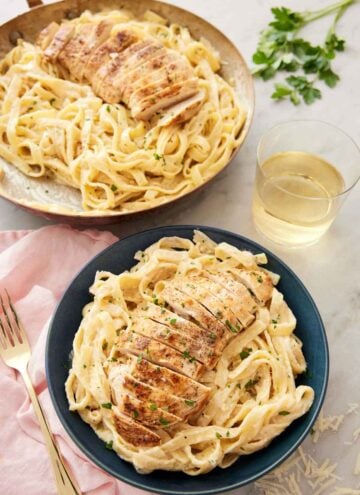
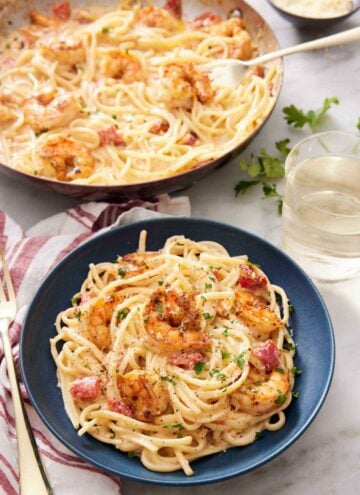
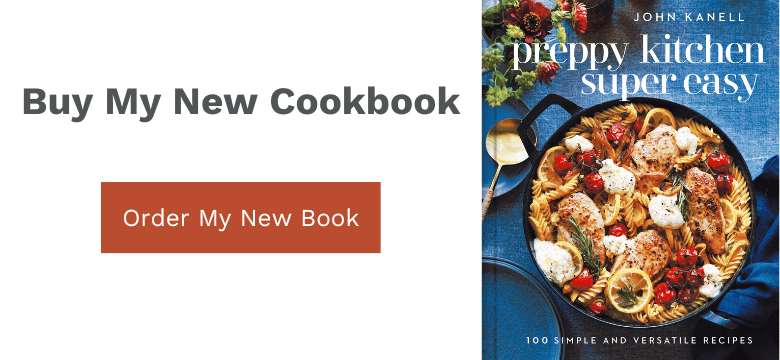
Leave a Reply